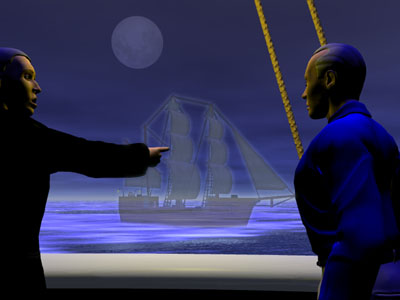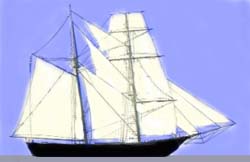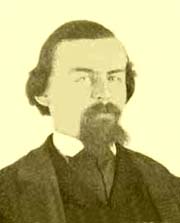pop up description layer
HOME
Cryptozoology UFO Mysteries Aviation Space & Time Dinosaurs Geology Archaeology Exploration 7 Wonders Surprising Science Troubled History Library Laboratory Attic Theater Store Index/Site Map Cyclorama
Search the Site: |
|
Phantom Ships Here comes the Flying Dutchman, comes fast through the hissing spray, And proceeding by the tempest he heads for Table Bay. With bird-like speed he's borne along before the howling blast, But he never can cast anchor there, for the Bay, alas, he's passed. - Traditional English Ballad One night near Cape John, Nova Scotia, drivers along the coastal road were startled to see a strange vision on the seaward horizon. One witness said, "It was a vessel, outlined with a fiery glow. I wouldn't say it was actually flames I saw... But the whole vessel was aglow and it was moving fast." The apparition lasted for two hours and was seen by dozens of people along the road. Was there really a burning ship out there? No, it was a phantom ship. Stories of many different phantom ships cover the pages of history. Some are purely folklore, others are documented facts. The burning ship of the Northumberland Strait has often been seen off the coast of Nova Scotia or Prince Edward Island in Canada. Often it appears as a three-masted sailing ship on fire. Another witness observed, "One October night I was returning from visiting a neighbor; while walking along I was looking out over the Northumberland Strait where I saw a ship burning. It was a clear night and I could make out the outline of the ship quite distinguishably. I watched it for about twenty minutes and then it disappeared. I had heard so much about the phantom ship that I decided that it must be it." Supposedly over the years several attempts have been made to reach the ship, but without success. One is detailed by Sterling Ramsay in his book Folklore of Prince Edward Island. Late one evening, approaching dusk, a ship [was]sighted in the harbor which appeared to be in peril. Some distance out in the channel was what appeared to be a huge three-massed sailing vessel ablaze from bow to stern. A group of men boarded a small boat and rowed toward the flaming ship, in hopes of rescuing as many of her crew as was possible. While they still were some distance from the craft, it disappeared into the mist and appeared to vanish completely. The burning ship Northumberland Strait is probably an optical illusion of unknown mechanism. Mirages are common along these waters, and often atmospheric conditions will make the coast of Nova Scotia look impossibly close to the shores of Prince Edward Island. At other times, the coastline is nearly invisible in the distance. Flying Dutchman Mirages may be part of the story behind the most famous phantom ship of all, The Flying Dutchman. The name Flying Dutchman actually refers to the captain of the vessel, not the ship. Legend has it that around the mid-17th century a Dutch vessel was trying to round the Cape of Good Hope at the tip of Africa. The seas there are notoriously treacherous and storms can make conditions even worse. The captain was distracted (or anxious to get home) and tried to round the Cape during bad weather. Despite the desperate conditions, the captain would not turn back, cursing to the heavens that he would round the Cape "even if it took all of eternity." In other versions of the tale, the captain plays dice with the devil with the understanding that if he wins, he will be transported around the Cape. He, of course, loses, and is sentenced to spend the rest of eternity trying to sail those waters. The Flying Dutchman has supposedly been seen by sailors in those waters for hundreds of years. Its appearance is considered a harbinger of doom. The most likely explanation for any Flying Dutchman sightings is that it is probably a mirage. A distant ship is magnified by atmospheric conditions to appear closer, perhaps even appearing in the sky or upside down. Such an apparition, without scientific explanation, would undoubtedly be labeled a ghost ship by any sailor who might see it. The Mary Celeste
While The Flying Dutchman and the Northumberland Strait burning ship might be a combination of legend and optical illusion, some phantom ships were quite real. Such is the case of the Mary Celeste, a sailing brig of the 19th century. The ship sailed from New York on November 7th, 1872, bound for Genoa, Italy, carrying 1701 barrels of alcohol. The captain, Benjamin Spooner Briggs, was considered to be a very able commander. With him sailed his wife and two-year-old daughter. The crew consisted of first mate, Albert Richardson, and six other sailors. On November 15th, another ship, the Dei Gratia, left New York following the same path as the Mary Celeste. The Dei Gratia's captain, a man named Morehouse, was acquainted with Captain Briggs and had dined with him before Briggs' ship had departed. Morehouse was very concerned when on December 5th he saw the Mary Celeste drifting aimlessly between the Azores Islands and the Portuguese coast. Morehouse attempted to signal the brig, but there was no response. Pulling alongside the ship, he sent a boarding party on board. The party found the ship and most of the cargo intact, but the captain, his family, and crew were gone. Legend has it that the ship was in perfect order with the table set for dinner and mugs of steaming coffee sitting around the cabin. The testimony of the boarding crew, however, documents that while the ship was sailable, it had apparently suffered the effects of being left adrift in heavy weather for several days. Deck hatches were open, and in between the decks of the ship there was standing water. In the galley, the stove was knocked out of position. When the cargo was later unloaded, it was found that nine barrels were empty. As one Dei Gratia crew member put it, "The whole ship was a thoroughly wet mess. The Captain's bed was not fit to sleep in and had to be dried."
The boarding crew dried out the ship and sailed it into the Bay of Gibraltar on December 13th. There, a Vice-Admiralty Court of inquiry was convened to determine what to do with the ship. Testimony shows that the boarding party was of the opinion that the crew had left the Mary Celeste in a great hurry. At least one small boat was missing as well as navigational instruments. The ship's log was left on board, however, with the last entry dated November 25th. It was not easy to find an explanation for what had happened. Piracy seemed out of the question as the cargo was almost completely intact. Also, there was no sign of violence on board and a mutiny was unlikely on such a short trip with a small crew. It was the opinion of the court that something had apparently scared the crew and they had taken to the boat to save their lives. What had scared them off their ship was unknown. Once in the small boat it isn't hard to imagine that the heavy weather might have sunk the fragile craft, leaving the Mary Celeste to sail on alone. Theories and Theories Over the years, many theories have been formulated as to what happened on the Mary Celeste. Newspapers at the time insinuated there might have been a scheme between Morehouse and Briggs to defraud the owners of the abandoned ship, but there is no real evidence for this idea and seems extremely unlikely given that Briggs was a part owner of the Celeste. One writer suggested that some of the crew got at the cargo, got drunk, and attacked the captain and his family. This also seems unlikely as the alcohol carried was not at all palatable. Another writer suggested a waterspout (a tornado over the ocean) hit the ship, sweeping the crew and passengers into the water. One intriguing theory forwarded by Captain Dave Williams is that the Mary Celeste was the victim of a "seaquake." A seaquake is an earthquake that occurs under the ocean. Depending on the type of quake, it can cause a ship on the surface to shutter violently. Williams proposed that the Mary Celeste was hit by a seaquake which knocked the stove out of its place and loosened the stays on the nine barrels of alcohol, spilling their contents thoughout the hold and into the bilge. As the fumes from the alcohol drifted about the vessel and into the galley where the loosened stove was spitting sparks, the captain and crew would have feared a violent explosion. The most reasonable course would have been to immediately launch the ship's lifeboat, tie it to the ship, and trail behind the vessel until the danger of explosion had passed. If for some reason that rope had parted, or in haste never been tied, the tiny life boat with the crew might never have caught up with the mother ship. In the strong winds and bad weather, they died at sea. The mysterious abandonment of the Mary Celeste might have remained a minor footnote in nautical history had it not been for Arthur Conan Doyle, the creator of Sherlock Holmes and author of such books as The Lost World. Conan Doyle penned a fictional short story based on the incident changing the name of the ship and entitling his work the Marie Celeste. Many of the details attributed to the real incident actually come from Conan Doyles' fictional story or the two movies made based on that story. The Baychinco Not all phantom ships are sailing ships. According to Philip and Nancy Seff, authors of Petrified Lightning, in 1931 the freighter Baychinco became a ghost ship of the Arctic Sea. The Baychinco was sailing near Point Barrlow, Alaska, when it became stuck in encroaching ice with the approach of winter. In this situation there was little for the crew to do but wait for the ice to break up so they could sail onward. While waiting, a raging storm came, and the captain, fearing that the ice's movements would crush the ship's hull like an eggshell, ordered the crew down onto the surrounding pack until the storm had passed. When the storm finally cleared, the crew was horrified to see that the ship was gone. There was no sign that it had broken up, leaving the captain to conclude that it had been broken free and was now drifting crewless among the Arctic ice packs. He was right. The phantom ship was spotted a number of times, but despite attempts to recover the vessel with its valuable cargo, no ship has been able to make contact. It was last spotted in 1964 and as far as anyone knows, is still haunting the cold waters of the far north. A Partial Bibliograghy Petrified Lightning by Philip Seff, Phd and Nancy R. Seff, M.Ed, Contemporary Books, 1996. History and Folklore of West Prince http://collections.ic.gc.ca/westpei/Phantom_ship.htm Was the Mary Celeste Abandoned During a Seaquake? by Captain Dave Williams, www.deafwhale.com/maryceleste/ Ghostly Encounters of the Northumberland Kind, 'The Island Magazine'. Spring/Summer 1978:4 By: William B. Hamilton Copyright 2004 Lee Krystek. All Rights Reserved. |
|
Related Links |
|
|






